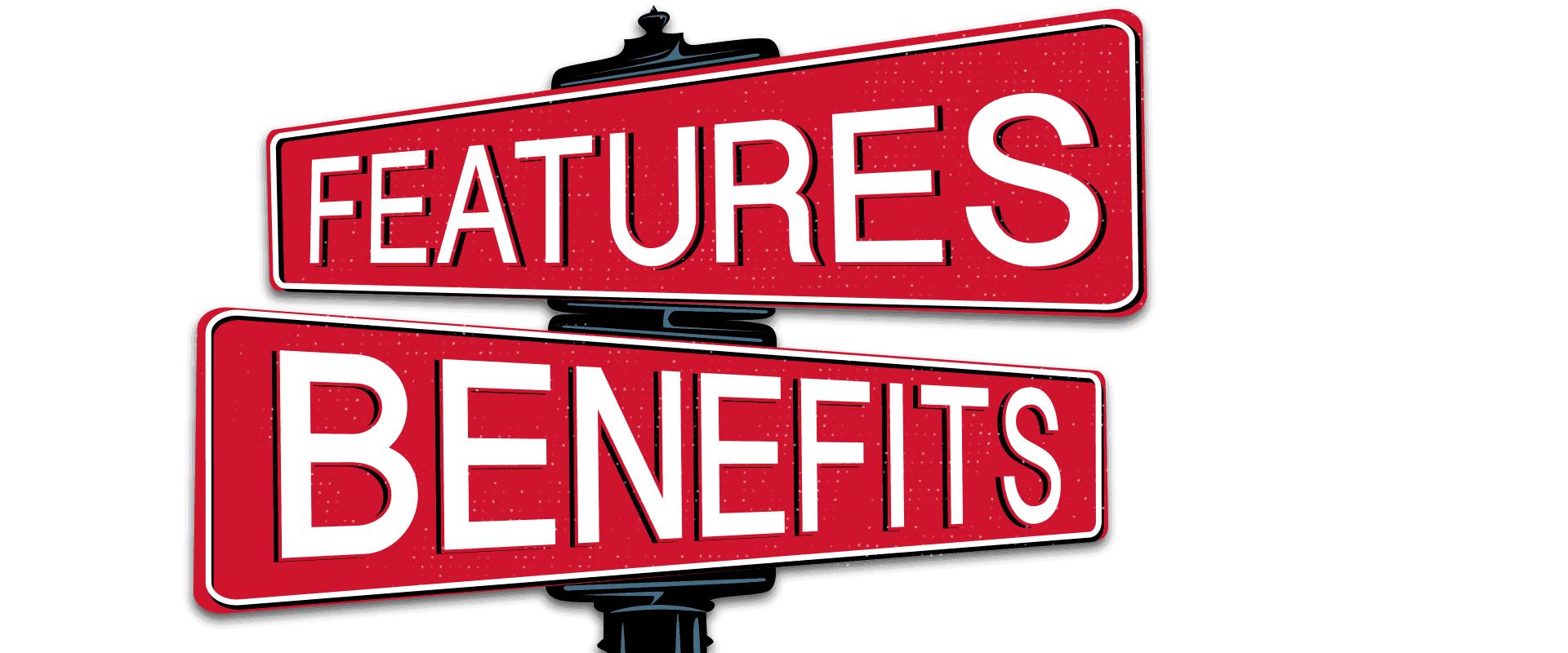This helps you sell better face to face and helps you write better content for the products.
If you study marketing gurus, they always tell you to focus on benefits rather than features when you write sales copy or create ads. Most business owners need help with the features vs. benefits dilemma. Most business owners need help understanding the difference. And because of this, only some small-business marketing efforts work!
Most small-business marketers assume that prospects will understand why they should buy the product just because they’ve been told about it. Therefore, business owners only communicate the features of their products to prospective customers and neglect to mention the benefits.
What Are Features?
Please look at the list of features below related to our products.
- Only 2 inches wide
- Only 4 inches high
- Locking Actuator
- Maintenance free
- Batteries included
Each is a feature — a factual statement about the product or service being promoted. But features are different from what entices customers to buy. That’s where benefits come in. A benefit answers the question, “What’s in it for me; how does this solve my problem?” meaning the feature provides the customer with something of value to them. This is where most businesses go wrong:
- The benefit of only 2 inches wide is that the stun gun is easy to hold.
- The benefit of only 4 inches high is the stun gun is easily concealable.
- The benefit of the locking actuator is the pepper spray has a safety switch.
- The benefit of maintenance-free is the customer will not have to fix anything.
- The benefit of batteries included is the product is ready to use out of the box.
While these may seem like actual benefits, they elaborate on the features. So what is truly a benefit?
The best way to understand the true benefit of your product, or to answer the “What’s in it for me; how does this solve my problem?” question, is to focus instead on the real reasons the customer thinks the features are essential. A customer’s perception of each feature’s real reasons attracts him or her to a particular product.
When someone chooses a stun gun that’s only 2 inches wide, the assumption is that the benefit is it’s easy to hold. Still, the real reasons are that it’s easier to grab in an emergency, making it quicker to use, making the user feel more confident in her ability to get it out of her purse and defend herself quickly — she feels safer. Those real reasons are the actual benefits.
When you try to sell the features of your products, you’re making the customer do all the work to figure out why they want the feature. I think it’s in your best interest to draw the connection for them. But to do that, you have to know the real reasons yourself. Let’s take another look at that features list to see the real possible reasons the customers like the features:
Only 4 inches high: If I carry a stun gun in my hand, I don’t want everyone to see it. I don’t want people to think I’m paranoid and afraid. Or, the bad guy won’t know I have it in my hand because it is so small, and I’ll be able to shock him before he even knows I’m carrying the stun gun. I won’t have to worry about him taking it away from me and using it on me because he doesn’t see it!
Locking Actuator: I don’t want this going off in my purse or when I’m showing it to friends. I’m afraid I might spray myself. I don’t want to look stupid.
Maintenance-free: I suck at fixing things. I want something that won’t break. I don’t want to feel dumb!
Batteries included: After I buy the product, I won’t have to worry about scrounging around the house looking for batteries or getting in the car and driving to Wal-Mart to buy some.
Even if you are using features and benefits in your sales copy and web pages, if you look again, you’ll likely see that your benefits are more features.
So now that you understand the difference between features and benefits, how do you apply this to your business so you can start marketing your benefits? I have three suggestions below for you.
1. Know your customer. To know your customer, you must gather as much information as you can about the customer. Try to collect demographic data (age, sex, household income, family size, marital status, media preferences, and so on) and psychographic data (attributes relating to personality, values, attitudes, interests, opinions, lifestyles, and so on).
If you are selling from a store or flea market and can talk to your customers face to face, you can start asking specific questions to begin developing a profile of your customers.
If you are selling online, the easiest way to get an accurate profile of your customers is to do a survey. You can offer a gift for their participation. The easiest to use is www.surveymonkey.com. Of course, this assumes you have a list of customers.
If you are just getting started, you will have to make some assumptions about who your customer is. Try to define that customer as precisely as you can. Even name him or her. When you write emails or sales copy for your website or ads, you write just to that person.
As your business grows, you will get a better feel for who your customer is and the problems they are trying to solve with your products.
2. Change your point of view. Whenever you write from your point of view, you naturally fill in the blanks with assumptions. No matter your business type, you think it’s great because you fully understand what you’re offering. But a prospect knows little or nothing about your products. They need to make the same connections about it that you can.
Your demographic and psychographic information will allow you to discover what patterns exist among your customers. Using that information, you must learn to put yourself in their shoes as the buyer. Approach your product as if you’d never seen it (which won’t be too hard for some of my distributors because they haven’t since we dropped ship for them). Then ask yourself, and anyone else who will help you, “What are the real reasons these features will benefit me?” and “Why would I want to consider buying or switching?
3. Think in terms of real reasons. There’s nothing wrong with the term “benefits,” but if you refocus the problem to think in terms of “real reasons,” the situation becomes more apparent. Your dilemma is more than features vs. benefits but features vs. real reasons. Start with your current features, and then take each into the real reasons phase. Try out what you get from friends or family to see which ones spark their interest.
When you use this “real reasons” approach to discovering your business’ benefits, you can be sure the marketing messages you use to reach your prospects will be on target. And that’s the most certain way to get business!



